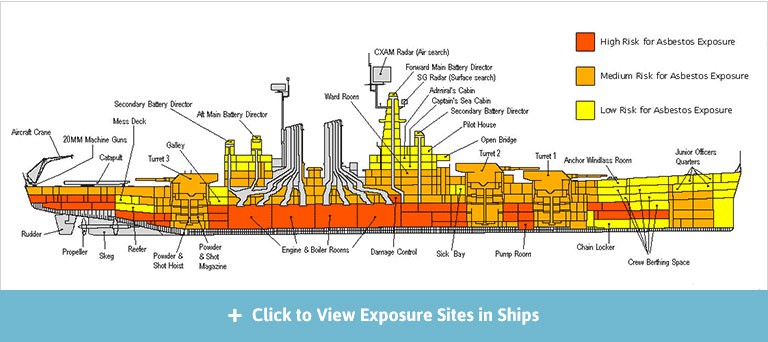Based on Your Reading:
Access Free VA Claims Assistance

Free Cancer Guide for Veterans

Find a Top Mesothelioma Doctor

Navy veterans face higher asbestos exposure risk because of extensive asbestos use in the military. This exposure can lead to mesothelioma. Veterans with mesothelioma may file for compensation through lawsuit settlements. Mesothelioma settlement payouts may range between $1 million to $2 million.
Written by Aaron Munz | Veterans Review By Nathan Pinner | Edited By Walter Pacheco | Last Update: July 23, 2024
Navy veterans were among those with the highest rates of asbestos exposure, putting them at significant risk of developing asbestos-related diseases including mesothelioma. The Department of Defense has identified 18 Military Occupational Specialties in the Navy that are considered “highly probable” to result in asbestos exposure.
Occupational exposure to asbestos, including exposure during military service, is the most common source of exposure. Military veterans are more likely to develop mesothelioma compared to the general population as a result of the U.S. Military’s particularly heavy use of the toxic mineral.
I grew up wanting to be in the Navy, probably since I was 12 years old. I was proud to be there, proud to serve. It was fun, too. It took me around the world three times. I never thought about any long-range danger.
Mesothelioma is a rare and very aggressive cancer that mostly occurs in the tissue lining the lungs, but can also occur in the lining of the abdomen, heart or testes. Exposure to asbestos is the primary cause of mesothelioma.
Asbestos is a mineral with heat-resistant properties that was used in a wide variety of products and industries into the 1970s. Asbestos products were used extensively in the U.S. Navy for decades.
Navy veterans exposed to asbestos during their military service are at risk of developing mesothelioma in their lifetime. Mesothelioma has a long latency period of 20-60 years, typically developing decades after asbestos exposure.
Because early mesothelioma detection and treatment are important to improving health outcomes, Navy veterans exposed to asbestos during their military service should have regular mesothelioma screenings. The U.S. Department of Veterans Affairs can provide screening, treatment and disability compensation for veterans with service-connected mesothelioma.
While older veterans are at the highest risk for developing mesothelioma, younger veterans and their families are also at risk for asbestos exposure and developing mesothelioma. Legacy asbestos can still be found in older housing, buildings, ships and equipment still in service.
Asbestos fibers can also be carried on shoes and clothing, leading to secondhand exposure. Family members typically come into contact with asbestos when doing laundry, hugging their loved one or from the transfer of asbestos fibers from work clothes or gear to carpets, upholstered furniture and other fabrics around the home.
Access Free VA Claims Assistance

Free Cancer Guide for Veterans

Find a Top Mesothelioma Doctor

U.S. Navy veterans with mesothelioma may qualify for VA benefits with a 100% disability rating. This allows them to receive more than $3,700 a month in VA benefits and health care. The VA offers benefits to veterans with a service-connected disability, medical condition and financial needs.
VA benefits can include medical care and monthly disability compensation based on your service-connected medical conditions. Veterans with service-connected disabilities who are married, have dependent children or have family members with special needs may be eligible for additional compensation benefits. VA benefits for spouses and dependent children continue after a veteran’s death. Even if you have mesothelioma that isn’t connected to your military service, you may still qualify for mesothelioma treatment at a VA hospital.
Filing a VA claim can be complicated, but the VA-accredited claims agents at The Mesothelioma Center have the experience to guide you through each step of the process. We can help you assemble the military records and medical documentation to support your claim, including a written summary of your exposure to asbestos.
Our VA claims agents work with Veteran Service Officers and veterans throughout the claims process. Filing a VA claim for benefits related to asbestos-related diseases requires a lot of documentation, but with the proper assistance, we can help you file a fully developed claim to speed the claims process. Additionally, our claims agents can connect veterans with other medical, financial and legal resources.

I want everyone to know that if you’re looking for information on how to start a claim for an asbestos-related disease, we can help you file a VA claim – line by line.
Individuals cannot sue the U.S. government over military asbestos exposure, but manufacturers of asbestos-containing products the Navy used can be sued. Mesothelioma settlement amounts for U.S. Navy veterans and their families typically range from $1 – $2 million. However, settlements and verdicts have awarded more than $70 million to U.S. Navy veterans and their families.
Navy veterans and their families can pursue a legal settlement to cover treatment expenses and other costs and to supplement income. Consult with an experienced mesothelioma lawyer for advice regarding how you and your family can file a mesothelioma lawsuit to recover expenses VA benefits don’t cover. Even those who don’t qualify for VA benefits can still file legal claims for asbestos exposure, including asbestos trust funds and lawsuits.
Asbestos was used extensively in ships and shipyards until the 1980s. Asbestos was used in many different products throughout ships, especially for insulation and fireproofing.
Navy veteran John Conway served on naval vessels involved in retrieving Mercury, Gemini and Apollo space capsules. While assigned to the USS Wasp, he also worked stripping asbestos from pipes below deck. “It used to look like it was snowing down there,” he told the Mesothelioma Center. At the time, he and other sailors were unaware of the health risks exposure to asbestos pose.
Asbestos Exposure Risks in the Navy
Buildings and housing on Navy bases also contained asbestos, putting both naval personnel and civilians working for the Navy and families living on bases in danger of exposure. Navy personnel serving in combat zones can also be exposed to asbestos when older buildings are damaged or destroyed. There are many potential sources of asbestos exposure for veterans of the U.S. Navy, the Coast Guard and Merchant Mariners.
Sailors with certain MOSs have a high probability of asbestos exposure based on their specific job requirements and locations on vessels where they work and live. The VA maintains a list of the occupations in the Navy and their risk of asbestos exposure.
Asbestos exposure on Navy ships can occur as a result of asbestos-containing equipment and working in areas with asbestos installation. Fire Controlmen, Firemen and others working with heat-resistant safety equipment can be exposed when using personal protective equipment made with asbestos.
Disturbing asbestos, such as during repairs, can also result in the release of asbestos fibers into the air. Shipyard workers can be exposed to asbestos when disassembling decommissioned ships made using asbestos.
U.S. Navy ships built between the 1930s through the 1970s used large amounts of asbestos in their construction. The highest risk for asbestos exposure comes from working in specific areas of the ship. Lower decks, including engine and boiler rooms and pump rooms, have the highest risk of exposure.

Asbestos exposure on ships affects both Navy sailors and U.S. Marines who lived and worked on Navy vessels. Extensive use of asbestos combined with tight quarters and poor ventilation resulted in the accumulation of asbestos fibers throughout ships, exposing those who didn’t work directly with asbestos.
Various U.S. Navy ships — including submarines — have used asbestos in their construction. Asbestos has been used in gaskets, pumps, pipe insulation, vinyl flooring, boilers, bulkheads, decks, insulation and other applications. Asbestos may be present throughout a ship, including living quarters.
Serving on any of these types of vessels puts you at risk of dangerous asbestos exposure. For Navy veterans, the type of ships you served on, the specific vessels and your occupation on those ships are important for determining your military asbestos exposure.
Working in other areas of ships can also lead to significant asbestos exposure, including around naval guns and the ship’s deck. Pipes covered with asbestos insulation run throughout some older ships, including through living quarters.
Navy veteran Bob Niemiec is a mesothelioma survivor who even doctors say defied the odds. “Every doctor we’ve seen all said it’s impossible medically for this man to still be alive, so it’s just not his time to go,” said Jeannie, his his wife of 55 years. Bob entered the Navy in 1965 at the age of 20. His first assignment out of boot camp was to scrape paint off of the landing ship U.S.S. Hermitage. It turns out the paint he was scraping contained asbestos.
Shipyards are high-risk sites for asbestos exposure. Ships and buildings were constructed using asbestos materials for decades. In addition to the dangers of the shipbuilding process, asbestos exposure could happen when ships are undergoing repairs and decommissioning.
Workers in shipyards had primary asbestos exposure, but those who came into contact with them were at risk of secondary asbestos exposure. Secondhand exposure poses a particular risk for family members and coworkers of shipyard personnel.
Products that contained asbestos were used everywhere in ships, from the deck to the engine room. Asbestos was used throughout Navy vessels for its durability, heat- and fire-resistant properties and its resistance to saltwater corrosion.
Asbestos-containing products found on ships include various types of insulation, machine parts and safety equipment. Many of these asbestos materials release dangerous asbestos fibers when damaged, so sailors performing repair and maintenance are at high risk for exposure.
Research shows enlisted U.S. Navy personnel were exposed to significant amounts of asbestos on ships, resulting in high rates of mesothelioma and other cancers. Although asbestos use is currently limited, the long latency of mesothelioma means that anyone who has served on older ships is at risk of mesothelioma from past asbestos exposure.
Jim A., a Navy veteran who served aboard the USS Renville, an attack transport ship in the 1960s, told The Mesothelioma Center, “You could say I was shocked about my pleural mesothelioma diagnosis, but not that big of a shock because I had always wondered after hearing so much about how dangerous asbestos turned out to be. I’m told, though, it was caught early.”
Even those who never worked around asbestos may still be at risk of developing mesothelioma and other asbestos-related diseases. Secondary asbestos exposure occurs when people are exposed to asbestos fibers carried on clothing, shoes and equipment.
Family members of sailors exposed to asbestos can be exposed to fibers inadvertently carried home from work. Naval shipyard workers often returned home at the end of the day covered in asbestos dust, leading to secondary exposure for their family members.
Similarly, secondary exposure can occur in barracks sailors share with someone exposed to asbestos. Secondary exposure also occurs in the workplace. Sailors, marines and civilians who share workspaces with individuals exposed to asbestos are at risk of exposure.

The average mesothelioma settlement is between $1 million and $2 million.
Access CompensationThe VA healthcare system offers cutting-edge treatment and cancer care for Navy veterans with mesothelioma. The VA can properly diagnose mesothelioma cases, and they even offer second opinions from mesothelioma specialists who work for the VA.
Even if you don’t live near a mesothelioma specialist, the VA offers virtual appointments and remote case management that allow a specialist to oversee and direct your treatment. The VA also reimburses travel expenses for veterans to receive covered medical care.
There are VA mesothelioma treatment centers across the country. VA medical centers in Boston, Los Angeles, Houston, Miami and Atlanta have mesothelioma specialists.

1400 VFW Pkwy West Roxbury, MA 02132
Year Built: Established in 1996
Number of Beds: 539 beds

11301 Wilshire Blvd Los Angeles CA 90073
Year Built: 1977
Number of Beds: 716 beds
The best step veterans can take to improve their prognosis is to undergo treatment for mesothelioma. Treatments that can extend survival, such as surgery, chemotherapy, radiation therapy and immunotherapy, are available through the VA.
The VA has mesothelioma specialists who offer cutting-edge treatments throughout the country to veterans coping with this cancer. These doctors specialize in mesothelioma cancer care and have extensive expertise in managing treatment plans to help patients live longer.

Los Angeles, California
Pleural Specialist | Thoracic Surgery
Expertise: Pleurectomy and Decortication, Clinical Trials
Languages: English, Spanish, Vietnamese

Franklin, Tennessee
Pleural Specialist | Thoracic Surgery
Expertise: Chest Wall Resection Immunotherapy
Languages: English
Veterans bear a heavy burden of asbestos-related cancer. The VA healthcare system has partnered with some of the best mesothelioma doctors in the nation to offer excellent mesothelioma cancer care.
The Navy discontinued the use of asbestos for new ships and bases in the 1980s. Veterans who served on naval vessels between 1930 and 1980 have a high risk of developing mesothelioma.
Asbestos was not completely removed or encapsulated on existing vessels and facilities until the late 1990s. Veterans who were deployed overseas may also have been exposed to other sources of asbestos.
Navy ships are no longer built with asbestos-containing materials. Ships that were constructed before the 1980s have also had any exposed asbestos removed or encapsulated. Asbestos on Navy ships does not present a health risk unless damaged or disturbed, but it can still be found on some older vessels.
If you believe you were exposed to asbestos while serving in the military, speak with your primary care physician about mesothelioma screenings. In many cases, veterans are eligible for VA asbestos disability benefits to cover the cost of medical bills and other expenses.
You can learn more about VA claims from our FAQ about VA benefits.
Navy veterans with mesothelioma are eligible for monthly VA benefits and healthcare. Available benefits for Navy veterans also include survivor benefits and specialized healthcare. Navy veterans may also file a mesothelioma lawsuit or an asbestos trust fund claim. Most legal claims end with a settlement. The average mesothelioma settlement payout is $1 million to $2 million, according to the latest Mealey’s Litigation Report.
In the 1970s, the Navy established the Asbestos Medical Surveillance Program. The AMSP monitors the health of veterans and civilians who were exposed to asbestos while working for the Navy and other military branches. This program helps track the medical status of individuals with known military occupational asbestos exposure to screen for mesothelioma and asbestosis. It also documents service-related exposure. This is important for filing a VA claim.
The sources on all content featured in The Mesothelioma Center at Asbestos.com include medical and scientific studies, peer-reviewed studies and other research documents from reputable organizations.
Your web browser is no longer supported by Microsoft. Update your browser for more security, speed and compatibility.
If you are looking for mesothelioma support, please contact our Patient Advocates at (855) 404-4592
The Mesothelioma Center at Asbestos.com has provided patients and their loved ones the most updated and reliable information on mesothelioma and asbestos exposure since 2006.
Our team of Patient Advocates includes a medical doctor, a registered nurse, health services administrators, veterans, VA-accredited Claims Agents, an oncology patient navigator and hospice care expert. Their combined expertise means we help any mesothelioma patient or loved one through every step of their cancer journey.
More than 30 contributors, including mesothelioma doctors, survivors, health care professionals and other experts, have peer-reviewed our website and written unique research-driven articles to ensure you get the highest-quality medical and health information.
My family has only the highest compliment for the assistance and support that we received from The Mesothelioma Center. This is a staff of compassionate and knowledgeable individuals who respect what your family is experiencing and who go the extra mile to make an unfortunate diagnosis less stressful. Information and assistance were provided by The Mesothelioma Center at no cost to our family.LashawnMesothelioma patient’s daughter


Munz, A. (2024, July 23). Navy Veterans With Mesothelioma. Asbestos.com. Retrieved November 20, 2024, from https://www.asbestos.com/navy/
Munz, Aaron. "Navy Veterans With Mesothelioma." Asbestos.com, 23 Jul 2024, https://www.asbestos.com/navy/.
Munz, Aaron. "Navy Veterans With Mesothelioma." Asbestos.com. Last modified July 23, 2024. https://www.asbestos.com/navy/.
A United States military veteran with knowledge of asbestos exposure reviewed the content on this page to ensure it meets current standards and accuracy.
Please read our editorial guidelines to learn more about our content creation and review process.
Retired Culinary Specialist and Senior Chief Nathan Pinner uses his extensive naval leadership, including service at the White House, to better serve other veterans.
Mesothelioma Center - Vital Services for Cancer Patients & Families doesn’t believe in selling customer information. However, as required by the new California Consumer Privacy Act (CCPA), you may record your preference to view or remove your personal information by completing the form below.
